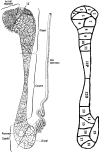Is the Epididymis a Series of Organs Placed Side By Side?
- PMID: 27122633
- PMCID: PMC5029429
- DOI: 10.1095/biolreprod.116.138768
Is the Epididymis a Series of Organs Placed Side By Side?
Abstract
The mammalian epididymis is more than a highly convoluted tube divided into four regions: initial segment, caput, corpus and cauda. It is a highly segmented structure with each segment expressing its own and overlapping genes, proteins, and signal transduction pathways. Therefore, the epididymis may be viewed as a series of organs placed side by side. In this review we discuss the contributions of septa that divide the epididymis into segments and present hypotheses as to the mechanism by which septa form. The mechanisms of Wolffian duct segmentation are likened to the mechanisms of segmentation of the renal nephron and somites. The renal nephron may provide valuable clues as to how the Wolffian duct is patterned during development, whereas somitogenesis may provide clues as to the timing of the development of each segment. Emphasis is also placed upon how segments are differentially regulated, in support of the idea that the epididymis can be considered a series of multiple organs placed side by side. One region in particular, the initial segment, which consists of 2 or 4 segments in mice and rats, respectively, is unique with respect to its regulation and vascularity compared to other segments; loss of development of these segments leads to male infertility. Different ways of thinking about how the epididymis functions may provide new directions and ideas as to how sperm maturation takes place.
Keywords: Wolffian duct; epididymal segments; epididymis; gene expression; male fertility.
© 2016 by the Society for the Study of Reproduction, Inc.
Figures


Comment in
-
Re: Is the Epididymis a Series of Organs Placed Side by Side?J Urol. 2017 Jan;197(1):234. doi: 10.1016/j.juro.2016.10.021. Epub 2016 Oct 15. J Urol. 2017. PMID: 27979556 No abstract available.
References
-
- Turner TT, Bomgardner D, Jacobs JP, Nguyen QA. Association of segmentation of the epididymal interstitium with segmented tubule function in rats and mice. Reproduction. 2003;125:871–878. - PubMed
-
- Hinton BT, Galdamez MM, Sutherland A, Bomgardner D, Xu B, Abdel-Fattah R, Yang L. How do you get six meters of epididymis inside a human scrotum? J Androl. 2011;32:558–564. - PubMed
-
- Thong A, Muller D, Feuerstacke C, Mietens A, Stammler A, Middendorff R. Neutral endopeptidase (CD10) is abundantly expressed in the epididymis and localized to a distinct population of epithelial cells–its relevance for CNP degradation. Mol Cell Endocrinol. 2014;382:234–243. - PubMed
-
- Johnston DS, Turner TT, Finger JN, Owtscharuk TL, Kopf GS, Jelinsky SA. Identification of epididymis-specific transcripts in the mouse and rat by transcriptional profiling. Asian J Androl. 2007;9:522–527. - PubMed
-
- Jelinsky SA, Turner TT, Bang HJ, Finger JN, Solarz MK, Wilson E, Brown EL, Kopf GS, Johnston DS. The rat epididymal transcriptome: comparison of segmental gene expression in the rat and mouse epididymides. Biol Reprod. 2007;76:561–570. - PubMed
Publication types
MeSH terms
Grants and funding
LinkOut - more resources
Full Text Sources
Other Literature Sources

